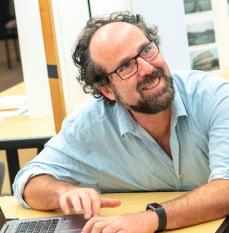
Richard A. Niesenbaum
Professor
Director of Sustainability Studies
New Science Building 327
484-664-3258
Visit Richard A. Niesenbaum's website
Education
B.A. Biology and Environmental Studies, University of Pennsylvania
M.S. Biological Oceanography, University of Connecticut
Ph.D. Biology/Ecology, University of Pennsylvania
Courses Taught
Plants and People (BIO 108)
Principles of Biology I (BIO 150)
Sustainable Solutions (SUS 405)
Community Sustainability in Costa Rica(SUS 350)
Field Botany and Plant Ecology (BIO 260)
Cultural and Economic Botany (BIO 262)
Research Interests
In my lab we focus on two distinct, but related areas, plant-insect interactions and conservation biology and sustainable development. Our studies of plant-insect interactions are focused on how abiotic and biotic environmental factors influence insect herbivory as mediated through leaf defensive chemistry. In the area of conservation biology and sustainable development, we are focused on developing ecologically integrated, urban food productions systems including the devleopment of urban aquaculture systems. We have also established a long-term, interdisciplinary research project in Abangares, Costa Rica where we are examining the environmental, cultural and public health aspects of artisinal goldmining. I currently have a book in progress on this topic with photographer Joseph Elliot. I am currently writing a book for Oxford Univeristy Press entitled Sustainable Solutions: Problem Solving for Current and Future Generations.
Selected Publications (for a complete list click here)
Mooney, E.H. and R.A. Niesenbaum. 2012. Population-specific responses to light influence herbivory in the understory shrub Lindera benzoin. Ecology 93(12): 2683-2692.
Ingersoll, C.M., R.A. Niesenbaum, C.E. Weigle and JH. Lehman. 2010. Total Phenolics and Individual Phenolic Acids Vary with Light Environment in Lindera Benzoin. Botany 88(11): 1007–1010.
Mooney, E.H., M.E. Edwards, and R.A. Niesenbaum. 2010. Genetic differentiation between sun and shade habitats in populations of Lindera benzoin L. Population Ecology, 52:417-425.
Mooney, E.H., E.J. Tiedeken, N.Z. Muth, and R.A. Niesenbaum. 2009. Differential induced response to generalist and specialist herbivores by Lindera benzoin L. (Lauraceae) in sun and shade. Oikos, 118:1181-1189
Muth, N.Z., E.C. Kluger, J.H. Levy, M.J. Edwards and R.A. Niesenbaum. 2008. Increased per capita herbivory in the shade: necessity, feedback, or luxury consumption? Ecoscience,15:182-188 (PDF).
Skoczylas, D., R.A. Niesenbaum, and N.Z. Muth. 2007. Top-down control of herbivory by insectivorous avifauna. Acta Oecologica, 32:337-342.
Edwards, M.E., and R.A. Niesenbaum. 2007. Eleven polymorphic microsattelite loci in Lindera benzoin, Lauraceae. Molecular Ecology Notes, 7:1302-1304.
Niesenbaum, R.A., J.F. Cahill, and C. Ingersoll. 2006. Light, wind, and touch influence leaf chemistry, growth, and rates of herbivory in Apocynum cannabinum (Apocynaceae). International Journal of Plant Sciences 167:969-978..
Niesenbaum, R.A., M.E. Salazar, and A.M. Diop. 2004. Community forestry in the Mayan Biosphere Reserve in Guatemala. The Journal of Sustainable Forestry 19:11-28.
Niesenbaum, R.A. and T. Lewis. 2003. Ghettoization in Conservation Biology: How interdisciplinary is our teaching. Conservation Biology 17:6-10.
